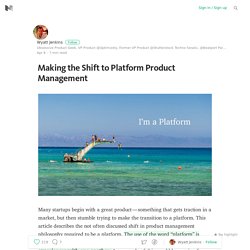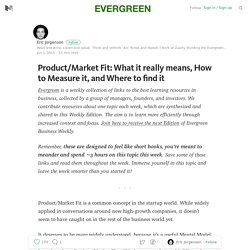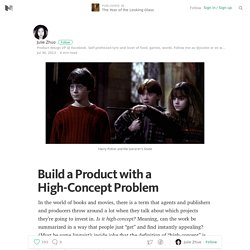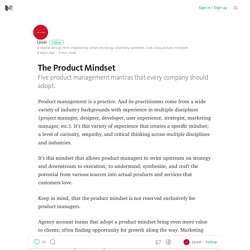

A Lean Approach To Product Validation. One of the biggest risks of building a product is to build the wrong thing.

You’ll pour months (even years) into building it, only to realize that you just can’t make it a success. At Hanno1, we see this happening time and time again. Making the Shift to Platform Product Management. Making the Shift to Platform Product Management Many startups begin with a great product — something that gets traction in a market, but then stumble trying to make the transition to a platform.

This article describes the not often discussed shift in product management philosophy required to be a platform. The use of the word “platform” is defined as a set of technologies that enable products to share data and experiences with one another. An example of this would be moving from a monolithic codebase to a common set of API’s or services and you often see in web services or operating systems. In my career I’ve been a product leader at three of these companies, some with more success than others. Product/Market Fit: What it really means, How to Measure it, and Where to find it — Evergreen Business Weekly.
Product/Market Fit is a common concept in the startup world.

While widely applied in conversations around new high-growth companies, it doesn’t seem to have caught on in the rest of the business world yet. It deserves to be more widely understood, because it’s a useful Mental Model for the interplay between a business, it’s products, and it’s customers. Learning about Product/Market Fit will help you see the world differently, and inspire new ways to create value for your customers, and growth for your business. Building Products — The Year of the Looking Glass. Building Products I recently gave a talk at TNW Europe about a framework we use at Facebook to help us focus our product development process.

Working on that talk got me thinking about the many other lessons I’ve internalized over the years about what it takes to build great products. This list is not complete nor certain. If there were some perfect step-by-step instruction manual out there (Step 1: Start with inspiration. Step 2: ??? The journey is 1% finished. On Framing. Build a Product with a High-Concept Problem — The Year of the Looking Glass. In the world of books and movies, there is a term that agents and publishers and producers throw around a lot when they talk about which projects they’re going to invest in.

Is it high-concept? Meaning, can the work be summarized in a way that people just “get” and find instantly appealing? (Must be some linguist’s inside joke that the definition of “high-concept” is the exact opposite of what it sounds like—high-concept is not sophisticated, hard-to-understand, or high-brow.)
An example of a high-concept novel: mistreated orphan boy attends secret boarding school for wizards. Now, there are probably far more elegant ways to describe Harry Potter and the Sorcerer’s Stone, but you get the gist. Other examples of high concept: Serial killer who only kills other serial killers. In each of those examples, there is a hook that is instantly intriguing. The same principle of high-concept comes up when talking about products and start-up ideas.
15 tips for building better products. We’re in it to build better products for our customers and make their lives better.

What makes certain products stand out? There is no easy answer… There is also no single way to build a successful product, so here are 15 tips – in no particular order – for building better products. Lower the cognitive load Help the user focus and perceive the process as less work while performing the necessary actions in smaller steps. If you can break the process into stand alone, easily understandable steps, the user will see it as a much faster experience. Celebrate small wins Help the user feel a sense of accomplishment with a positive feedback. Always learn about the context When getting feedback, don’t just leave it at what the user has to say. The Product Mindset. The Product Mindset Five product management mantras that every company should adopt.

Product management is a practice. And its practitioners come from a wide variety of industry backgrounds with experience in multiple disciplines (project manager, designer, developer, user experience, strategist, marketing manager, etc.). It’s this variety of experience that creates a specific mindset; a level of curiosity, empathy, and critical thinking across multiple disciplines and industries. It’s this mindset that allows product managers to swim upstream on strategy and downstream to execution; to understand, synthesize, and craft the potential from various sources into actual products and services that customers love.
Keep in mind, that the product mindset is not reserved exclusively for product managers. Agency account teams that adopt a product mindset bring even more value to clients; often finding opportunity for growth along the way. 1. Business value and user value are interdependent. 2. 3. 4.